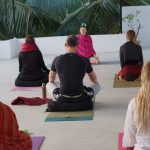Roxie and I shared only a few passionate weeks together. But during our wild rides, that aging, but sexy, VW van taught me many important yoga lessons that I’ll never forget.
Our first meeting was unexpected. The owner of a yoga studio near where I was staying introduced her to me. He needed someone to cover a few yoga classes, but the studio was 24 miles away, and I didn’t have a car.
“You can borrow Roxie,” he said.
“Roxie?”
“Yes, our VW van.”
You named your van Roxie? A yoga teacher driving a VW van? Really? Isn’t that a stereotype? Should I buy some patchouli and tie-dye shirts to wear while driving her? The studio was stuck, though, so I agreed.
Roxie was exactly what I expected — that squarish shape with the lawnmower engine in the back. She also had a sticker on her back windshield — Roxie, in feminine cursive. Even better, she was a VW Westfalia Camper — or Westy — which meant that she had a refrigerator and bed inside, and a pop-up roof. Sweet ride, indeed.
Look To Your Quirks For Yoga Lessons
 Roxie was older and, as you may find, when you start to age you develop a few “quirks.”
Roxie was older and, as you may find, when you start to age you develop a few “quirks.”
- Her side-view mirrors were taped on, so I couldn’t adjust them to see out the sides. The oddly-shaped rear windshield restricted my visibility out the back, as well. That meant I could only see out the front.
- The speedometer was in kilometers, which didn’t really matter because it didn’t work. “When you get up to about 90 km/hour, Roxie starts to shake,” the studio owner told me. Good to know.
- The gas gauge worked, but only when the tank was almost empty. When I filled the tank, I could only put in $20 worth of gas. Otherwise, the gas would spill all over the place.
- When I started Roxie, I had to press down the gas pedal halfway, or else she’d stall. She would occasionally backfire and blow off her engine hoses.
- The steering wheel had a lot of play to it. With a strong wind, Roxie swerved from side-to-side and the steering wheel did little to counter it.
Roxie was much different from the well-maintained car-share vehicles I’m used to driving. But she came with a cool Australian hat, and a tattered journal to record my adventures.
I made it safely to and from yoga class in Roxie. She didn’t seem to mind that I stalled her at almost every light, or lurched forward — or backwards — whenever I started her because I had my foot on the gas pedal to avoid stalling.
With winter approaching, though, it was time to return Roxie to her family. With the leaves almost completely off the trees, I dropped her off. I returned the Australian hat to its place on the passenger seat, and gave Roxie a kiss on her windshield.
Yoga Lessons From Roxie, With Love
Don’t rely on external gauges to tell you how fast you are moving, or how hard you are working. Take away the mirrors, the teachers and the other students. What’s left is your yoga practice. Tune into your body — your breath, your muscles, your mind — to know when to back off, or when to turn it up a notch.
Pain is a sign of something bad. At times, I felt Roxie’s pain as she groaned when I turned the steering wheel too hard, or shuddered when I took a bump too quickly. Learn to recognize similar warning signs in your body, such as pain and grinding, especially in the joints. Yoga should not be painful. If you feel pain, come out of the pose and assess what you were doing. Some pain is more subtle and may take years to present as a physical problem or injury.
Know where you are in space. Sometimes you can’t see what is behind you, or what your pose looks like. That doesn’t mean you should fling yourself around as if no one else is there. Pay attention to where your body begins and ends. Notice how it moves through space when you do yoga, walk or eat.
Be mindful. Driving Roxie required nearly constant attention. She’s not the type of car that drives herself. Even simple thoughts like wondering about dinner can lead to drifting off the road or hitting a pothole too hard. Being mindful doesn’t mean forcing your mind to be still. It’s about letting your mind return to its natural relaxed state. In your yoga practice, how long can you sustain your attention on your breath or pose before drifting off? Work on this every time you step onto the mat.
It’s not always about getting there quickly. When you slow down your practice, you start to notice things that you would have otherwise missed. Are you using the wrong muscles to sustain a pose? Do you avoid poses or parts of poses because they make you uncomfortable? Is the heat too much for you? Also, don’t expect to achieve every pose right away. Some poses take weeks — or years — of preparation. When you let go of your destination, you can really start to enjoy each point along the way.
__________
Photos by goingslo and Handolio, some rights reserved







